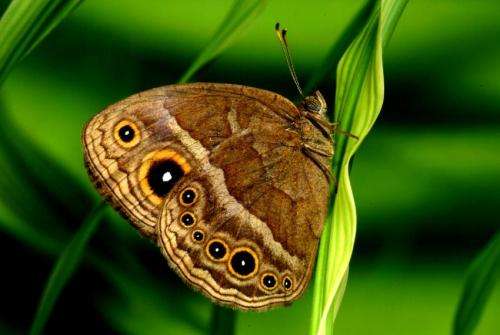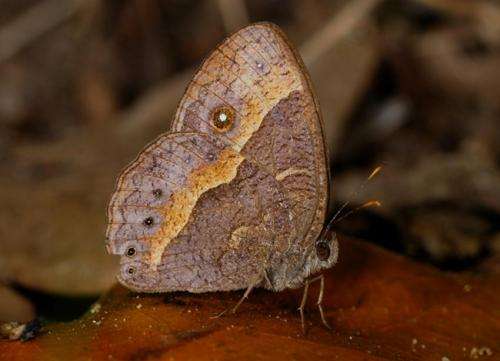'Eyespots' in butterflies shown to distract predatory attack

Research has demonstrated with some of the first experimental evidence that coloration or patterns can be used to "deflect" attacks from predators, protecting an animal's most vulnerable parts from the predators most likely to attack them.
The study, published today in Proceedings of the Royal Society B, in fact shows that one species of butterfly uses its "eyespots" not only for protection, but varies the color and intensity of them by season as the types of predators change.
The findings were made by researchers from Oregon State University, Yale University and four other institutions.
"Eyespots are conspicuous, they draw your attention and are thought to be used by many animal species to avoid death or attack, by either startling or confusing the predator," said Katy Prudic, lead author on the study and a researcher with the Department of Integrative Biology in the College of Science at Oregon State University. "Many insects have eyespots, which suggests they are an important adaptation."
The butterfly species studied, Bycyclus anyana, produces about five generations a year during both wet and dry seasons in its native habitat. Through a process scientists call "phenotypic plasticity," the same genes can produce two different eyespot patterns in the adults. Warm temperatures of the wet season create large and bright eyespots, while cool temperatures common in the dry season produce dull and small eyespots.
During the wet season, the large eyespots make a colorful target for attack, conceptually similar to a matador waving a cape that distracts a charging bull into attacking the wrong thing.
In this season, predatory insects such as the praying mantids are their greatest enemy, and the showy eyespots on the wings led the mantids to attack the butterfly wings rather than the more vulnerable body or head. The wings are badly damaged, but the insect can escape and live to reproduce.

During the dry season, most insect predators are dead but birds abound. For birds, the smaller, dull eyespots make the butterfly more difficult to detect and consume.
"Having the right type of eyespot in the right season allowed the butterflies to live long enough to lay eggs and have more offspring in the next generation," Prudic said. "With the wrong eyespot at the wrong time, they were quickly annihilated by the mantids."
Color pattern has always been a form of protection against predators in nature, Prudic said. It can take the form of camouflage, mimicry, delaying or redirecting attacks. But studies that observed and hypothesized about such changes have been difficult to document in controlled experiments such as this.
Eyespots are one of nature's favorite forms of misdirection, shared by fish, frogs, birds, and many insects. Aside from deflecting attack, they can also be used as a "startle" mechanism, being flashed just long enough to delay attack briefly and allow a species to escape. Researchers also believe eyespots can play a role in sexual attraction and mate selection.
More information: Invertebrate predators attack eyespots and promote the evolution of phenotypic plasticity, Proceedings of the Royal Society B, rspb.royalsocietypublishing.or … .1098/rspb.2014.1531
Journal information: Proceedings of the Royal Society B
Provided by Oregon State University

















